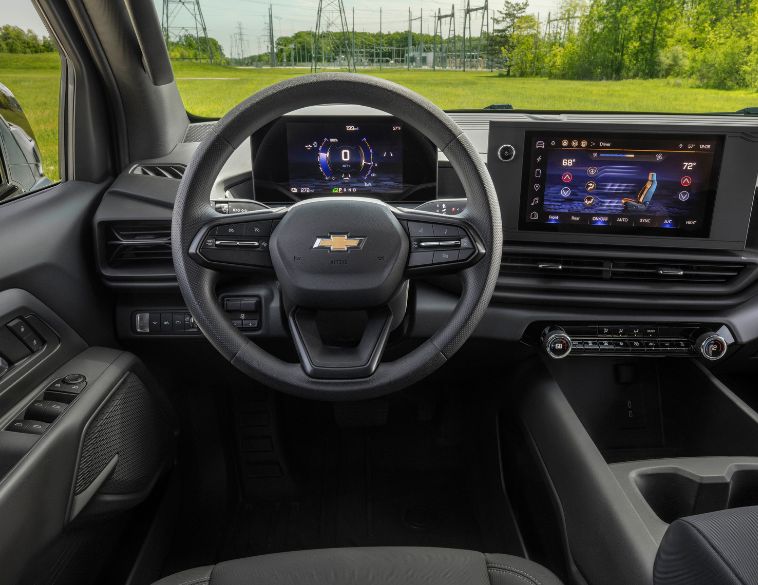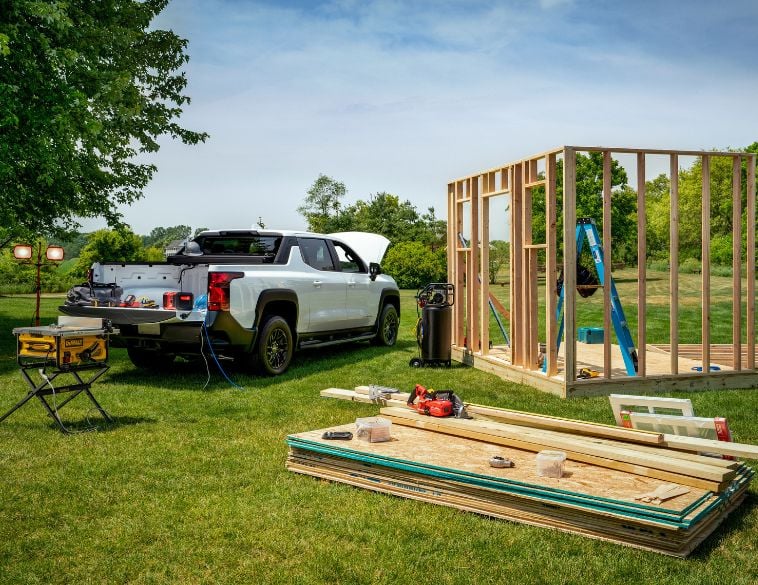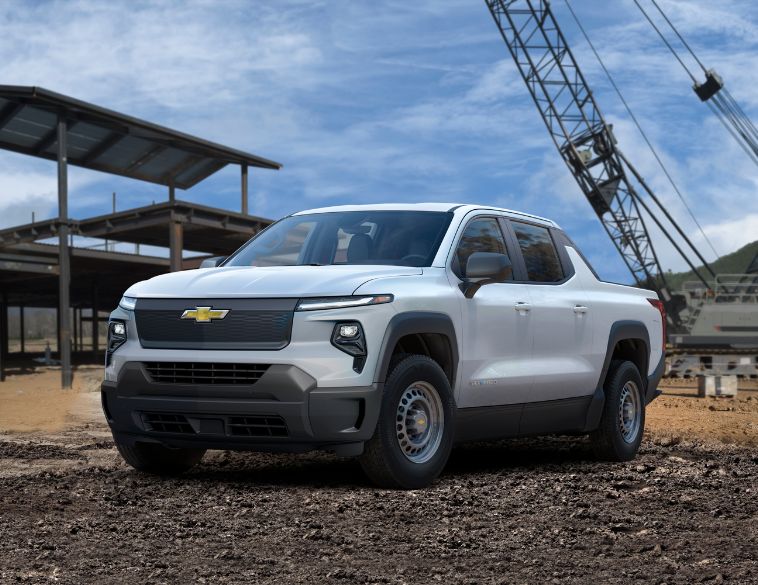New electric pickup looks set to raise the bar in terms of performance and capability.
Since it went from a trim level to a full vehicle nameplate for the 1999 model year, the Chevrolet Silverado has consistently been the brand’s top selling vehicle. Generations of Canadians have come to depend on this full-size pickup’s practicality and dependability. In fact, from 2014 through 2023, nearly 800,000 units were sold to Canadian customers, with these trucks consistently selling more than 50,000 copies annually since 2017.
Given the popularity of the Silverado, plus the push toward vehicle electrification across North America in recent years, including mandates set by the Government of Canada, it was only a matter of time before the Silverado was reimagined as an electric vehicle.
While some Original Equipment Manufacturers (OEMs) have chosen to base their EVs on existing internal combustion engine designs, the Silverado EV was conceived, from the ground up as a battery electric vehicle. It rides atop General Motors’ Ultium EV architecture and, according to Dave Watson, Director of GM Envolve in Canada: “we didn’t convert an ICE vehicle into an EV. Our engineers designed the Silverado EV from the ground up to provide customers with a true work-capable truck. The Silverado EV combines capability, performance and versatility that will assist our GM Envolve customers with achieving their own sustainability goals.”
The Silverado EV features unibody construction as opposed to a full frame found on most pickups. And, because it utilizes GM’s Ultium platform and incorporates an expansive battery pack like that found in the Hummer EV, a specific goal was the creation of a fully electric truck that compromises neither strength, performance, nor durability, while at the same time delivering a compliant ride and good passenger comfort, whether on or off-road.
Aiding the latter is four-wheel, fully independent coil-sprung suspension as well as front and rear electric motors that form the basis of the vehicle’s e4WD system.
At launch, the 2024 Silverado EV initially comes only as a Work Truck (WT) model, though a consumer-oriented RST First Edition will be made available in the first half of the year. For our audience, the WT naturally proved of interest, so, in an effort bring insight into what this new Silverado EV offers for fleet customers, we saddled up and sampled one for a few days.
Our test vehicle, finished in Summit White, looked purposeful, sporting 18-inch black alloy wheels shod in LT265/70R-18 Bridgestone Alenza A/S 02 all-season rubber. All Silverado EVs come in crew-cab configuration with four, full-size doors and a 5-foot, 11-inch cargo bed. From a visual standpoint, this new electric truck almost looks like a re-imagined Avalanche, with its dramatic C-pillar design that blends into the cargo box.

Fleet oriented
Nevertheless, unlike the Avalanche, the minute you climb into the Silverado EV WT, there’s plenty of evidence this vehicle is aimed at fleets and contractors. There are rubber floors, allowing easy wash and wipe down after a day’s work on the muddy jobsite or farm. And, while the dark grey plastic and durable Evotex covered seats that envelop the interior may cry industrial functionality, for a work truck, Chevrolet has added some features to make driving and operating this vehicle a little more than a simple, no frills jobsite tool. Perhaps the biggest (pun intended) is the amount of interior space. The back 60/40 split bench seat feature a healthy amount of legroom—more even than a regular Silverado crew cab, and both front and back, the cushions are wide, comfortable, and supportive. A massive central storage bin with up to 41.6 litres of available space is also welcome.
A bone of contention with some EVs, is the way the controls are laid out, dominated by massive touch screens that require swiping your hands for just about every function, including HVAC and driving position adjustments. Thankfully, GM has recognized the inherent issues with this, namely that it can take 10-15 minutes to set the air cabin temperature or choose your favourite radio station and if the screen fails, nothing works.
Speaking with Craig Campbell, National EV Sales Manager, GM Envolve, this was a prime consideration when designing the Chevrolet Silverado EV and falls in line with new Euro NCAP standards that require all new vehicles to have physical input capability for key vehicle functions. As a result, although the Silverado EV boasts two screens, an 8.0-inch display in the instrument cluster and a centrally mounted 11.0-inch unit that contains a raft of features including navigation, charging, infotainment and exterior cameras, you’ll also find physical controls for items such as steering wheel adjustment, mirrors, hazard warning lights, and even temperature and radio volume controls.
There’s also a shift lever on the right side of the steering column, meaning that anyone that’s driven a regular Chevrolet Silverado will feel right at home in the new EV model, plus the driving position is very comfortable, even after longer stints on the road, a hallmark of GM full-size pickups for many years.

Driving dynamics
In terms of driving dynamics, the Silverado takes a little getting used to, especially if you haven’t driven an EV before—or in particular—a fully electric pickup truck. Flick the shift lever into drive, release the brake and off you go. Because there’s no noise coming from under the hood (sorry, eTrunk), all you hear is tire noise and the faint whirr of electric motors. One thing we should mention is that the Silverado EV is heavy. The massive battery pack weighs 1326 kg (2,923 lbs) alone (about the curb weight of a small car) causing the Silverado EV to tip the scales at a stout 3855 kg (8500 lbs). That puts it in the mass range of an HD model and significantly more than a regular ½ ton.
Nevertheless, when you drive the Silverado EV, it doesn’t feel like giant behemoth. The steering is responsive, and particularly impressive at low speeds where a tight turning circle makes the Silverado EV far more agile in most parking lots than a full-size pickup has any right to be.
In terms of acceleration, the truck’s dual electric motors provide very strong get-up and go, with torque delivery that would shame some high-powered, big cube muscle cars. GM rates power output of the WT at 510 hp and 615 lb-ft of torque, while reporting a 0-96 km/h (0-60 mph) time of 5.4 seconds—impressive considering the truck’s weight.
Ride comfort is also good and there’s a noticeable absence of jitter from the rear end, even when driving on rough, pothole riddled roads or washboard surfaces, where traditional pickups with live rear axles can prove to be jarring and unpredictable at times.
Big pickups are not known for their handling qualities and while nobody will mistake the Silverado EV for a Corvette, it delivers surprisingly good performance through the turns. Body roll is there but the truck feels stable and well planted, aided by its wide footprint and low centre of gravity.
Range
It’s also worth at this point, stating the truck’s range, since this will likely be a deciding factor for many fleet customers. GM has gone to great lengths to try and make the Silverado EV as appealing as possible to fleets, since not only are they laser focused on price and total cost of ownership, but other factors such as payload, towing capability, and range.
The 24-module Ultium battery pack as fitted to our test vehicle, boasts 724 km (450 miles) of range on a single charge, while extra effort has been made to reduce drag coefficient (Cd is 0.33, the lowest of any GM full-size pickup). The Silverado EV boasts a narrower and more streamlined front-cross section than its ICE counterpart and Campbell also pointed to the more steeply raked windshield and cab-forward design, that are designed to help it slice through the air more efficiently.
Further helping in the range department, is the truck’s regenerative braking system. Campbell demonstrated the truck’s multiple modes that allow the driver to adjust the amount of regeneration via the centre mounted 11-inch touch screen.
Like other EVs, a one pedal driving function mode can be turned on and off. When engaged, it provides more aggressive regenerative braking, can be particularly useful when driving around town, as it allows the truck to slow without touching the brake pedal and at the same time add storage capacity to the battery, boosting the truck’s range. We tested the Silverado EV in both one pedal and regular driving mode, and, under normal driving conditions, braking is strong and consistent, far more than you’d expect on a traditional truck or even passenger car.
While we weren’t able to subject the Silverado EV to a towing test during our time with the vehicle, GM says that with the 24-module Ultium battery, the WT is able to pull up to 10,000 lbs behind it, something that will likely be of serious consideration among fleet customers, especially those that so far, have been sceptical to the true payload and towing abilities of full battery-electric trucks. The WT also offers a Tow/Haul mode, as well as trailer hitch provisions and an integrated trailer brake controller and hitch guidance to sweeten the deal.
Other nifty features include no fewer than seven onboard power outlets, including four located in the pickup bed. The Silverado EV WT can provide a maximum of 7.2 kilowatts of charging through these outlets, more than enough to run an assortment of power tools on the job site, as well as appliances and even charging residential buildings for short periods. An available accessory power bar boosts that to 10 outlets and 10.2 kW of power. Additionally, the front eTrunk is designed to allow contractors and workers to securely store their most important power tools and equipment and can swallow 303 litres (10.7 cu. ft.) of kit.

Charging
No review of a full battery electric vehicle is complete without looking at charging capability and support. Silverado EV Work Truck Customers have access to Ultium Charge 360 Fleet Service, which is designed to provide one of the industry’s most comprehensive charging solutions for business. It offers a considerable amount of flexibility allowing fleet drivers and employees, to have their vehicles charged overnight at a central depot or taken home to the employee’s residence and charged there.
In terms of charging capacity, the Silverado EV has several tricks up its sleeve. The first is that even though the truck is built around a 400-volt architecture, the Ultium battery pack offers the option of switching from parallel to series connection, meaning that when hooked up to a fast charger, GM says that 160 km (100 miles) of range can be added in as little as 10 minutes, since in this configuration it can charge up to 350 kW on an 800-volt cycle. This provides significant time savings for fleet customers who need to charge the vehicle while on the go. And, given that fleets need to keep their vehicles moving and in use as much as possible, this is something that is likely further to appeal to potential customers.
One drawback, however, concerns the existing charging infrastructure and network. Depending on where your business is located, this might prove a minor or major inconvenience. Our test of the Silverado EV took it from the confines of GM’s fleet operations in Oshawa, Ontario, along the 401 corridor and up through Kawartha Lakes, into central Ontario cottage country.
While the Energy Assist feature in the myChevrolet Mobile App, enables drivers to pinpoint the location and type of chargers, along with a helpful feature that shows if they are available and/or in use, the trouble is that fast chargers are still not widespread, especially in smaller towns and more rural locations. Therefore, careful planning is still the order of the day, particularly when operating extensively in these kinds of areas.
While GM has announced it will adopt the North American Charging Standard (NCAS) receptors as used by Tesla for its Supercharger network, current vehicles don’t have this capability so that’s something to consider when looking to purchase or lease a Silverado EV WT.
Additionally, GM is also part of a joint venture initiative that includes seven global OEMs, with the goal of bringing more than 30,000 public fast chargers on stream. These will be designed to be accessible to all BEV vehicles, using NCAS or the Combined Charging System (CCS). The first stations are expected to be operational in the U.S. during the summer of 2024, with Canada likely to follow suit. This is something to bear in mind, particularly for fleets that are looking at longer term BEV procurement.
Pricing
Speaking of that, GM Canada has just announced pricing for the Silverado EV. At launch, the 3WT has a base MSRP of $74,699 plus Destination Freight Charge (DFC), which is competitive against other battery electric vehicles in the light commercial marketplace. Customers are also encouraged to look for provincial and federal incentives where available, which can help ease concerns regarding purchase/leasing and total cost of ownership.
While there is no question that full EVs still aren’t for everyone, General Motors has put considerable effort in creating a battery-electric pickup that’s designed to get the job done. For those fleets that are looking to reduce their carbon footprint and meet long-term environmental sustainability goals, the Silverado EV, given its range, performance, road manners and versatility, arguably represents the best option yet in terms of a practical and capable pickup—one that just happens to deliver zero emissions at the tailpipe.



